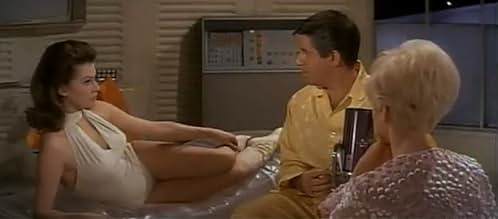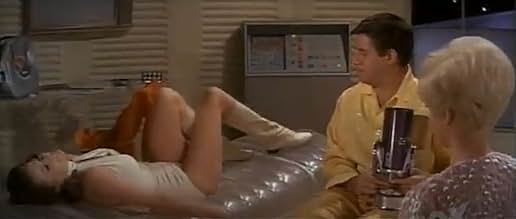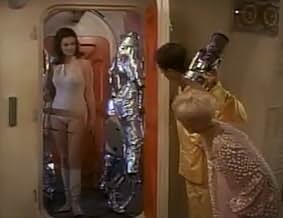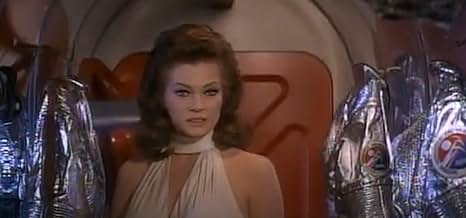Ajouter une intrigue dans votre langueIn a futuristic world, the USA decides to send a married couple of astronauts to its moon base in order to prevent any improper contact with the Soviet female cosmonauts manning the USSR moo... Tout lireIn a futuristic world, the USA decides to send a married couple of astronauts to its moon base in order to prevent any improper contact with the Soviet female cosmonauts manning the USSR moon base.In a futuristic world, the USA decides to send a married couple of astronauts to its moon base in order to prevent any improper contact with the Soviet female cosmonauts manning the USSR moon base.
- Réalisation
- Scénario
- Casting principal
- Deuce Hawkins
- (as Alex D'Arcy)
- Narrator
- (voix)
- (as Colonel John 'Shorty' Powers)
- Ceremony Guest
- (non crédité)
Avis à la une
At least a good director experienced in handling Jerry, like Frank Tashlin or Norman Taurog, could have possibly made something out of this, but Gordon Douglas was always a director (?) whose main virtue was that he could bring in films on-time and at or under budget. Douglas' films were successful because of either their stars or stories ("Robin and the Seven Hoods," the Carroll Baker "Harlow"), but he himself was a director of workmanlike competence and no more. It's a reputation he upholds here, with his indulgent direction and sluggish pacing.
All of which proves, once again, that Jerry Lewis' last really good film on his own was "The Nutty Professor." After that, he started believing his press clippings, especially his foreign ones, and, after a while, he wasn't as much funny as downright pathetic. And "Way... Way Out" is a textbook example of this.
For example in CINDERFELLA there's that scene where he's trying to light his stepbrother's cigarette. No music, no dialogue, no camera motion at all. Just 120 seconds of pure disaster. Or in NUTTY PROFESSOR there's the hilarious scene where he timidly enters the dean's office--again, no sound, no words, just a thick, hilarious atmosphere.
WAY... WAY OUT has a few of those types of gags, and they were brilliantly done, including one of the funniest gags I've ever seen ("If I'm not mistaken, that's Stella Mary right there"). Unfortunately the film seemed to switch gears halfway through, once they're on the moon, and it became more of a silly sitcom. Still, I enjoyed it until the end.
A word about the visual presentation: magnificent! Sure, we don't generally go to Jerry Lewis movies to see artistic cinematography, but it's there. The sets are surreal (futuristic in a cool retro-60s way). Everything was large and colourful. Shots are framed wonderfully (be sure to see it in widescreen). The camera moves smoothly and brilliantly throughout the action. But then, as I said above, everything changes once they're on the moon. The sets become smaller, more claustrophobic and less grandiose. This returns us to the silly sitcom feel.
Overall it was wacky & entertaining. I think it's best watched by people who are familiar with Jerry's subtle style, rather than his slapstick skits. For that reason I'm afraid most people will be disappointed. But a few of you may really enjoy it.
Jerry Lewis does less of his wacky character here, and tries playing it straight, not for gonzo laughs. He's nearly laid back compared to Robert Morley's curtain rattling performance as Jerry and Connie Stevens "first married couple on the moon. He's a handler like Leo G. Carroll was for Napoleon Solo in the Man From Uncle. Brian Keith appears several times in short inserts as a gruff-but-still-gruffer General who orders third act action where Jerry must "secure the moon".
Sure, all the sets are drenched in futuristic lighting as the story is set sometime after the Sixties, doesn't say when though. So in the background are cool concept cars of the future, during the Earth based scenes. You see solid patches of red and brilliant white furniture,(and very cool clear, plastic pillows), straight out of movies like "In Like Flint" or the British set designer for Sixties movies Ken Adam.
The Moon base location has cool looking pods for sleeping/working--and yes the patented "Batman"-style, big, blinking lights computers are strewn all over your eyeline, which I totally loved as a kid. Lighting-wise, the production simply pours all available light at all times during the indoor moon scenes, which has a television-feel about it; later verified by the technical names, especially Jack Martin Smith, who worked scores of sci-fi/fantasy pics during the Sixties for TV and low budget independents.
The film is super-sexy with tease galore supplied by Anita Ekberg's fab legs, shot from at least three angles during her opening house call on the American married couple living next door on the moon. There's all sort of adult-level innuendo that flew over my head at the time: things about wife swapping, watching two girls makeout on one's wedding night, and others that are cleverly enfolded into the dialog, some PC types of the Two-Thousands would call this "leering" and it probably is, hehe.
Dick Shawn as the Tarzan-like Russian counterpart to Jerry simply does his patented "thing" with grimacing and good accents. There's an extended sequence of everybody getting drunk and kinda swapping, which today's producers would be cutting out because bad things happen to people who drink to excess, right? --oh yeah everybody knows that. The drunk thing was big in the sixties for some reason. Dick Shawn's other picture that year "What Did You Do In The War, Daddy?" had him being drunk through days of story time.
Seeing this movie without any warning would certainly remind some of Austin Powers; it's inescapable really. However I saw this tonight with a 28 year old who reminded me, "Austin Powers got it's look from this, not the other way around"
Le saviez-vous
- AnecdotesSome of the sets were recycled for Perdus dans l'espace (1965) that was being filmed around about the same time.
- GaffesOn their first night on the moon the valve on Pete's pillow appears and disappears.
- Citations
[First lines]
Narrator: This is Colonel John "Shorty" Powers in Lunar Launch Control. This story takes place near the turn of the century -not the last century, the *next* century. Nothing very much has happened since the 1960's: There as still a United Nations, and peace in the world... or at least what we have come to accept as "peace".
- ConnexionsFeatures Frankenstein (1931)
- Bandes originalesWay... Way Out
Words by Hal Winn
Music by Lalo Schifrin
Sung by Gary Lewis & The Playboys (as Gary Lewis and the Playboys)
Meilleurs choix
- How long is Way... Way Out?Alimenté par Alexa
Détails
- Date de sortie
- Pays d’origine
- Langue
- Aussi connu sous le nom de
- Way... Way Out
- Lieux de tournage
- Sociétés de production
- Voir plus de crédits d'entreprise sur IMDbPro
Box-office
- Budget
- 2 955 000 $US (estimé)
- Durée1 heure 45 minutes
- Couleur
- Rapport de forme
- 2.35 : 1






















